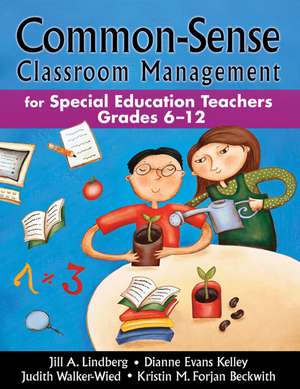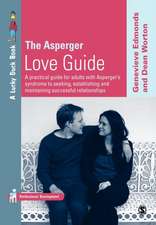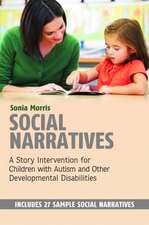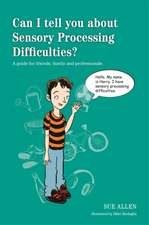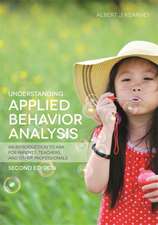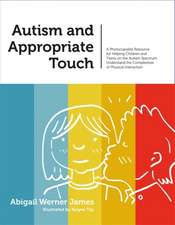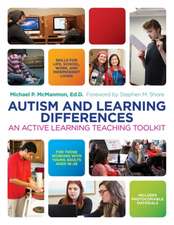Common-Sense Classroom Management for Special Education Teachers, Grades 6-12
Autor Jill A. Lindberg, Dianne Evans Kelley, Judith K. Walker-Wied, Kristin M. Forjan Beckwithen Limba Engleză Paperback – 22 mai 2007
| Toate formatele și edițiile | Preț | Express |
|---|---|---|
| Paperback (1) | 296.25 lei 6-8 săpt. | |
| SAGE Publications – 22 mai 2007 | 296.25 lei 6-8 săpt. | |
| Hardback (1) | 513.68 lei 6-8 săpt. | |
| SAGE Publications – 12 iun 2007 | 513.68 lei 6-8 săpt. |
Preț: 296.25 lei
Nou
Puncte Express: 444
Preț estimativ în valută:
56.69€ • 59.46$ • 47.19£
56.69€ • 59.46$ • 47.19£
Carte tipărită la comandă
Livrare economică 01-15 aprilie
Preluare comenzi: 021 569.72.76
Specificații
ISBN-13: 9781412940399
ISBN-10: 1412940397
Pagini: 160
Dimensiuni: 216 x 279 x 11 mm
Greutate: 0.45 kg
Ediția:1
Editura: SAGE Publications
Colecția Corwin
Locul publicării:Thousand Oaks, United States
ISBN-10: 1412940397
Pagini: 160
Dimensiuni: 216 x 279 x 11 mm
Greutate: 0.45 kg
Ediția:1
Editura: SAGE Publications
Colecția Corwin
Locul publicării:Thousand Oaks, United States
Recenzii
"Uses humor while providing straight forward suggestions for the new teacher. User friendly with pertinent information and resources for the new teacher."
"As I read, I kept thinking to myself just how appropriate the title was. The book is a compilation of just what it says—common-sense solutions and suggestions. I liked the chapter titles because I knew exactly what would be in each chapter."
"Teachers will love the straight forward, practical information. The topics and strategies are excellent."
"Practical information is presented in a clear-cut, easy-to-read format."
"Provides great insight for developing and organizing your overall daily routine, planning, and teaching."
"Reflects what I've experienced in my co-teaching with three different experienced special education teachers. Reading the chapters on 'Legal Issues' and 'Working with Support Staff' gave me a new appreciation for the amount of out-of-classroom activities for which a special education teacher is responsible."
"Serves as a good resource for the teacher who may be struggling with an aspect of classroom management and is seeking new strategies."
"The authors' ability to collaboratively pinpoint current classroom issues and offer direct problem-solving approaches is impressive. This easy-to-implement resource with its organized chapter outlines and well-crafted format are flexible and adaptable to any grade, subject, or ability level. Abounds with suggestions to assist the educator in creating a positive classroom atmosphere."
"A valuable reference for any special education teacher. With a focus on classroom management, the guide covers all aspects of teaching from paperwork to professional relationships. New and veteran teachers will find useful tips and indispensable resources to improve their practice and enrich their learning."
"As I read, I kept thinking to myself just how appropriate the title was. The book is a compilation of just what it says—common-sense solutions and suggestions. I liked the chapter titles because I knew exactly what would be in each chapter."
"Teachers will love the straight forward, practical information. The topics and strategies are excellent."
"Practical information is presented in a clear-cut, easy-to-read format."
"Provides great insight for developing and organizing your overall daily routine, planning, and teaching."
"Reflects what I've experienced in my co-teaching with three different experienced special education teachers. Reading the chapters on 'Legal Issues' and 'Working with Support Staff' gave me a new appreciation for the amount of out-of-classroom activities for which a special education teacher is responsible."
"Serves as a good resource for the teacher who may be struggling with an aspect of classroom management and is seeking new strategies."
"The authors' ability to collaboratively pinpoint current classroom issues and offer direct problem-solving approaches is impressive. This easy-to-implement resource with its organized chapter outlines and well-crafted format are flexible and adaptable to any grade, subject, or ability level. Abounds with suggestions to assist the educator in creating a positive classroom atmosphere."
"A valuable reference for any special education teacher. With a focus on classroom management, the guide covers all aspects of teaching from paperwork to professional relationships. New and veteran teachers will find useful tips and indispensable resources to improve their practice and enrich their learning."
Cuprins
Preface
Acknowledgments
About the Authors
1.Getting Organized
Student Information
Supplies and Materials
Your Desk and Surrounding Areas
Forms and Schedules
Room Arrangement
Wall Displays
2.Organizing Students
Preparing for Class
Storage Systems
Daily Oganizational Strategies
Routines and Rules
Peer Buddies
3. Delivery of Special Education Services
Determining Level of Educational Services for Students With Academic Disabilities
Determining Level of Support for Students With Behavioral Challenges
Providing Educational Services
Developing Your Schedule to Support Students
Sharing Student Information
Providing Services to Students With Disabilities Through Collaboration
Special Education Instructional Planning
4. Positive Behavioral Supports
Classroom Management and Coteaching
Providing Indirect Behavioral Support to Students Within the Inclusive Classroom
Managing Behavior in the Special Education Classroom
Addressing Individual Student Behavior Challenges
Managing Special Education Classrooms Designed for Students With Extremely Challenging Behavior
Tokens of Recognition and Other Fabulous Prizes
Activity Reinforcers
Backup Plans for Students Not Earning the Incentive
Consequences
When You Must Discipline
Functional Behavioral Assessment and Behavior Intervention Plan
Conducting a Functional Behavioral Assessment
Developing a Behavior Intervention Plan
5. General Education Instructional Planning
Your Involvement in the General Education Classroom
Planning for Academic Success
Planning for Behavioral Success
Grading Students With Disabilities
Coteaching and Co-planning
6. Specially Designed Instruction
Implementing the IEP
Finding Appropriate Materials
Individualized Work
The IEP and Assistive Technology
Using Assistive Technology as a Learning Support
Learning Strategies
Transition Planning
Transition Planning for Students Bound for Postsecondary Education
Instruction in Behavior
7. Legal Issues
Changes to the IEP Process as Required by IDEIA
Transition
Student and Parent Rights
Transfer of Rights
Functional Behavioral Assessments and Behavior Intervention Plan
Manifestation Determination
8. Working With Families
Before You Contact Families . . .
Establishing and Maintaining a Positive Relationship
IEP Meetings
Parent Conferences
Documentation
Assistance From School Support Staff
9. Working With Support Staff
The IEP and Support Staff Involvement
Support From the Special Education Administrative Staff
Support From the School Psychologist
Support From the School Social Worker
Support From the Guidance Counselor
Support From Transition Service Providers
Other Support Staff
10.Working With Teacher Assistants
Making a Schedule
Communication
Presenting a United Front
Assigning Responsibilities
Discussing Concerns
11. Working With Administration
Understanding Your Principal's View of Special Education in Your School
Communicating With Your Principal
Principal Observations and Evaluations
Professional Development
What Is a Professional Learning Community?
12.Working Within Your School Community
Becoming Part of the Team
Teacher Buddies and Mentors
To Socialize or Not to Socialize
The Teachers' Room
Ask for Help, Offer to Help
Other Supports for New Teachers
References
Suggested Readings
Index
Acknowledgments
About the Authors
1.Getting Organized
Student Information
Supplies and Materials
Your Desk and Surrounding Areas
Forms and Schedules
Room Arrangement
Wall Displays
2.Organizing Students
Preparing for Class
Storage Systems
Daily Oganizational Strategies
Routines and Rules
Peer Buddies
3. Delivery of Special Education Services
Determining Level of Educational Services for Students With Academic Disabilities
Determining Level of Support for Students With Behavioral Challenges
Providing Educational Services
Developing Your Schedule to Support Students
Sharing Student Information
Providing Services to Students With Disabilities Through Collaboration
Special Education Instructional Planning
4. Positive Behavioral Supports
Classroom Management and Coteaching
Providing Indirect Behavioral Support to Students Within the Inclusive Classroom
Managing Behavior in the Special Education Classroom
Addressing Individual Student Behavior Challenges
Managing Special Education Classrooms Designed for Students With Extremely Challenging Behavior
Tokens of Recognition and Other Fabulous Prizes
Activity Reinforcers
Backup Plans for Students Not Earning the Incentive
Consequences
When You Must Discipline
Functional Behavioral Assessment and Behavior Intervention Plan
Conducting a Functional Behavioral Assessment
Developing a Behavior Intervention Plan
5. General Education Instructional Planning
Your Involvement in the General Education Classroom
Planning for Academic Success
Planning for Behavioral Success
Grading Students With Disabilities
Coteaching and Co-planning
6. Specially Designed Instruction
Implementing the IEP
Finding Appropriate Materials
Individualized Work
The IEP and Assistive Technology
Using Assistive Technology as a Learning Support
Learning Strategies
Transition Planning
Transition Planning for Students Bound for Postsecondary Education
Instruction in Behavior
7. Legal Issues
Changes to the IEP Process as Required by IDEIA
Transition
Student and Parent Rights
Transfer of Rights
Functional Behavioral Assessments and Behavior Intervention Plan
Manifestation Determination
8. Working With Families
Before You Contact Families . . .
Establishing and Maintaining a Positive Relationship
IEP Meetings
Parent Conferences
Documentation
Assistance From School Support Staff
9. Working With Support Staff
The IEP and Support Staff Involvement
Support From the Special Education Administrative Staff
Support From the School Psychologist
Support From the School Social Worker
Support From the Guidance Counselor
Support From Transition Service Providers
Other Support Staff
10.Working With Teacher Assistants
Making a Schedule
Communication
Presenting a United Front
Assigning Responsibilities
Discussing Concerns
11. Working With Administration
Understanding Your Principal's View of Special Education in Your School
Communicating With Your Principal
Principal Observations and Evaluations
Professional Development
What Is a Professional Learning Community?
12.Working Within Your School Community
Becoming Part of the Team
Teacher Buddies and Mentors
To Socialize or Not to Socialize
The Teachers' Room
Ask for Help, Offer to Help
Other Supports for New Teachers
References
Suggested Readings
Index
Notă biografică
Jill A. Lindbergretired from Milwaukee Public Schools in June 2003 and is currently a supervising teacher for the University of Wisconsin-Milwaukee. Her teaching experience includes six years as a mentor teacher, assisting both general and special education teachers in Milwaukee Public Schools. She has taught students with specific learning disabilities, students with emotional/behavior disabilities, and students with hearing impairment. She has coauthored five books in the Common-Sense Classroom Management series with educators from the Milwaukee area. She has a degree in exceptional education from the University of Wisconsin-Milwaukee.
Descriere
These 80 easy to adapt strategies work in five steps or fewer to help special educators feel confident about working with co-teachers, teacher aides, support staff, administrators, and families.
